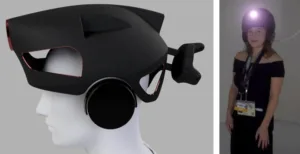As it has for the past several years, Sony used the occasion of the recent SXSW conference (Austin, TX) to show off several ongoing experimental projects. This year, the company’s presentations included the so-called Superception Head Light system.

The Head Light system can, perhaps, best be described as a wearable helmet using projection-based mixed reality technology.
The word Superception is a trademark of Sony Corporation. It is formed by a combination of the words super and perception. Superception is described as “a research framework that uses computer technologies to intervene in the process of human perception and to connect multiple senses together in order to alter and expand the limits of perception.” The company explains that “if conventional engineering to access digital data or to perform real world functions using computers is to be referred to as ‘interface engineering,’ the approach we take with Superception is ‘perception engineering’.”
In applying Superception to the Head Light system, the idea is that, rather than to simply display information, to use the projection from the system to demonstrate how technology can affect human perception through a person’s various senses.
The system consists of a helmet with a Sony MP-CL1 projector mounted on the front. Sony MDR-XB950 headphones are attached on the sides. A HTC Vive tracker is attached to the back of the helmet. The helmet is tethered to a computer. The Head Light System is illustrated in the figure below.
The Head Light System
Images are projected by the helmet over a wide viewing angle. This enabled users to move around a room while the projected video images follows the user’s movements.
To show the capabilities of and the potential for the Head Light system, Sony prepared several demonstrations. More specifically, demos were intended to “allow users to expand their human perception and explore the perceptual sensory world of non-human species.” The demonstrations showed how:
- Mosquitos use smell to find blood. In this demo, the headphones played buzzing sounds. The projector showed Sony’s idea of what the world would look like to a mosquito. In addition, smell alerts occasionally went off during the demo.
- Butterflys see the world. In this demo, the projector broadcasted a colorful, abstract mosaic pattern.
One on-line reviewer commented that “I did not understand what I was supposed to take away from the experience.” Sony had previously commented on the goal of the Head Light experience. The comments were along the line that they were trying to answer the question “how could we integrate the different perceptual abilities to human beings?”
A video at the end of this article demonstrates the Head Light system in operation.
The company goes on to explain that “we are becoming capable of precisely controlling human inputs and outputs by applying sensing technologies and virtual reality. We believe that Superception will be an engineering platform to control such human senses.”
Despite Sony’s enthusiasm for the Head Light, the ultimate use case for the system is not yet clear. Drawing upon a variation of a favorite old saying: the Sony Head Light projector helmet is a solution looking for a problem to solve. Sometime the “if you build it they will come” approach succeeds. In the case of the Head Light system, the results are not yet in. -Arthur Berman

